It might be obvious from some of my projects, but I love coffee. In 2018, I started with a cheap espresso maker. It broke rather quickly, but in doing so, it sparked my deep interest in coffee.
Getting Started with Espresso
There are countless guides on what makes a good espresso. Factors like grind coarseness, coffee dosage, bean selection, and grinder quality all play a role (always grind fresh!). Then, there are standard guidelines:
- Espresso should take around 25 seconds from the first drop to the last.
- The typical ratio is around 1:2.5—meaning if you use 15g of coffee beans, you aim for 37.5g of espresso in your cup.
But the most important rule? These are just starting points. The real goal is always taste — the most important part is that the espresso tastes the way you want it and that you enjoy the process of making it.
Why an Espresso Maker?
One question I hear a lot from guests is: “Why an espresso maker? Doesn’t the whole process feel tedious?”
Well, yes and no.
A fully automated machine simplifies life, but that also means you end up drinking more coffee just because it’s so convenient. There’s also the cleaning aspect — manual espresso machines with portafilters allow for thorough cleaning, whereas most automatic machines provide little access to their internal brewing components.
And then, of course, there’s the taste. I’ve yet to find an automatic espresso machine that matches the flavor of a well-dialed-in manual espresso shot. Why shouldn’t your home-brewed espresso taste just as good as the one from your favorite coffee shop?
Quickmill Cassiopea
After my first espresso maker broke, I bought the Quickmill Cassiopea. This machine features dedicated thermoblocks for both coffee extraction and hot water/steam, allowing simultaneous espresso pulling and milk frothing.

The good part about the coffee machine was the quick heat-up time thanks to the thermoblocks. The bad parts were the weak steam power and that the group head is Quickmill-specific, limiting the accessories available for it.
E61 Group Head
After a few years, I wanted to try an E61 group head. I sold my Quickmill at a small loss and started looking for a new machine. After some research, it came down to two machines.
Lelit Mara X vs. Bezzera Magica S
Both machines use the E61 group head, meaning a wide variety of accessories are available. Apart from aesthetics, the key difference was that the Mara X offers temperature control settings and different brewing modes:
- Steam Priority Mode – Functions like a traditional E61 machine.
- Coffee Priority Mode – A Lelit-specific setting that optimizes for espresso extraction.
NOTEThe modes have evolved over time — if you buy a Mara X today, it may have different options.
In the end, the Mara X simply made better-tasting espresso in my testing, so I went with it. Since September 2020, I’ve been very happy with my choice.

The Big Drawback: Heat-Up Time
A common downside of E61 machines is their long heat-up time. Lelit states 24 minutes, but real-world measurements show that stability is achieved after 30 minutes. And temperature stability is critical for consistent shots.
My solution? A WiFi smart plug that preheats the machine automatically. While this helps, it doesn’t allow for spontaneous espresso-making. Plus, E61 machines consume a lot of energy compared to thermoblock machines since they heat an entire boiler just to extract a few milliliters of espresso.
Final Thoughts
Like many hobbies, espresso making can become a deep rabbit hole. There’s an overwhelming amount of information online, sometimes to the point, where you optimize settings, despite liking the taste already.
Would I buy my setup again? Probably not.
Since purchasing the Mara X, new machines have emerged. While I appreciate the E61 experience, I dislike the long heat-up times and high energy consumption. Yes, the smart plug is a decent workaround, but spontaneous espresso isn’t really an option.
Enjoyed the post? Have questions or feedback? I'd love to hear from you! Feel free to drop me an email at blog@jerey.at.

